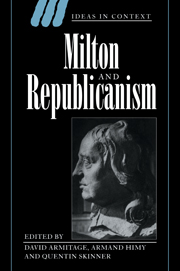Book contents
- Frontmatter
- Contents
- Notes on contributors
- Preface
- PART I DEFINING MILTON'S REPUBLICANISM
- PART II MILTON AND REPUBLICAN LITERARY STRATEGY
- 4 Biblical reference in the political pamphlets of the Levellers and Milton, 1638–1654
- 5 The metaphorical contract in Milton's Tenure of Kings and Magistrates
- 6 Milton, Satan, Salmasius and Abdiel
- 7 Paradise Lost as a republican ‘tractatus theologico-politicus’
- PART III MILTON AND THE REPUBLICAN EXPERIENCE
- PART IV MILTON AND THE REPUBLICAN TRADITION
- Index
- Recent titles in the series include
4 - Biblical reference in the political pamphlets of the Levellers and Milton, 1638–1654
Published online by Cambridge University Press: 27 October 2009
- Frontmatter
- Contents
- Notes on contributors
- Preface
- PART I DEFINING MILTON'S REPUBLICANISM
- PART II MILTON AND REPUBLICAN LITERARY STRATEGY
- 4 Biblical reference in the political pamphlets of the Levellers and Milton, 1638–1654
- 5 The metaphorical contract in Milton's Tenure of Kings and Magistrates
- 6 Milton, Satan, Salmasius and Abdiel
- 7 Paradise Lost as a republican ‘tractatus theologico-politicus’
- PART III MILTON AND THE REPUBLICAN EXPERIENCE
- PART IV MILTON AND THE REPUBLICAN TRADITION
- Index
- Recent titles in the series include
Summary
The margins of the religious and political pamphlets of the early 1640s were often crammed with abbreviated references to biblical texts; these are usually deleted from recent editions of the great Puritan writings. The original pamphlets of the Levellers, who were struggling for political change during the 1640s, often carry the same dense accumulation of references from the Old and New Testaments. This essay stems from the curiosity aroused by these italics in fine print. The question that arises is how did the Levellers use such a mass of biblical references and how did that use compare with the way Milton handled biblical tropes as he too attacked the established church and then worked to justify the revolutionary political strategy of the late 1640s?
During the first Civil War the imperatives of further religious reformation formed a driving force for political change. Later, in the years 1646 to 1649, they gradually gave way both to a more secular rhetoric and to more clearly political priorities. But at a crucial point in the virtually un-kinged community, religious images returned to the forefront within the ‘Saints” ideology as a remedy for disorder. These were cultural representations that men and women easily understood. Such images took hold and, among other factors, their seductive power became the cement of the fragile commonwealth of the 1650s, Britain's only experience of a republic.
This paper addresses the question of the use of the material from the Bible – in the form of quotations and set, even stock images – in this political process.
- Type
- Chapter
- Information
- Milton and Republicanism , pp. 63 - 81Publisher: Cambridge University PressPrint publication year: 1995
- 1
- Cited by



